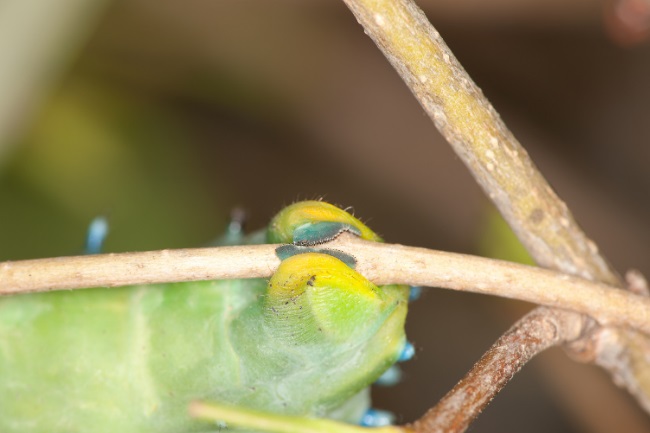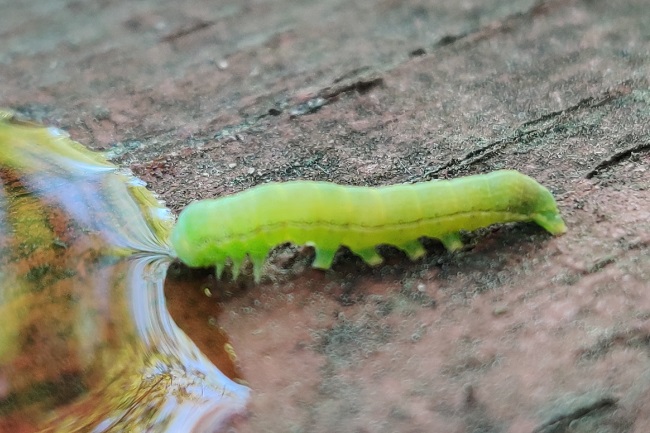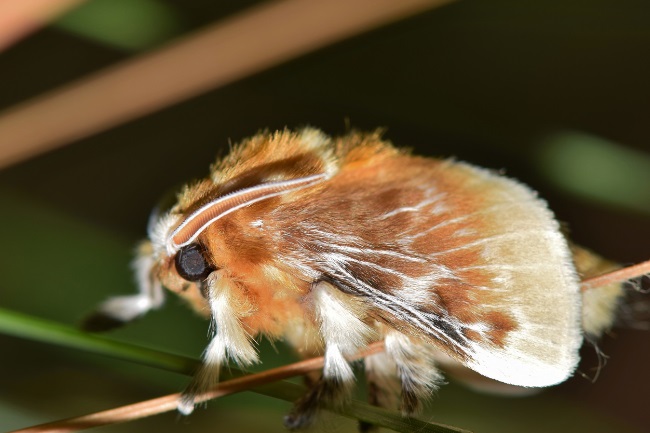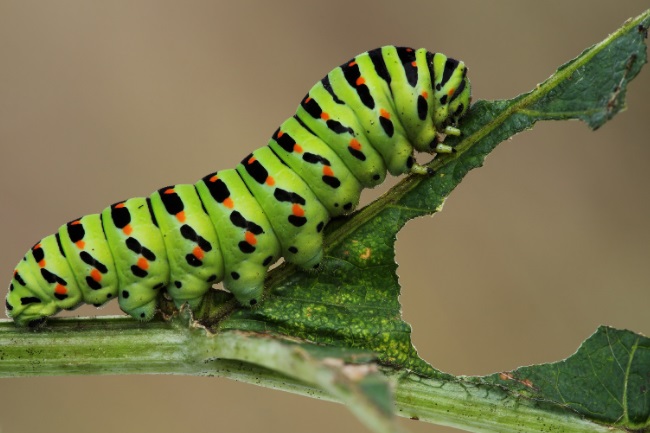Caterpillars do have legs, though the number varies between species. Their legs can be divided into two groups, true legs and prolegs. True legs are segmented legs and always come in three pairs, whilst prolegs are unsegmented and vary between two and five pairs.
Contents
What is a leg?
What a leg is and does may seem like an arbitrary question for many of us. Looking at any animal, we’d quite quickly be able to point out which parts of its anatomy make up the legs. Whether it’s a giraffe or a mouse, it isn’t too complicated to get the question right. Yet when it comes to caterpillars, they don’t play by the rules.
If you were watching a caterpillar move its way across the floor, I’m sure you’d quickly be able to point out its many little ‘legs’. These tiny body parts are one of the things that make caterpillars so fascinating to watch as they undulate their way through the world. Yet all is not what it seems, and not all those legs are legs.
Also read: Centipedes Have 100 Legs: Myth or a Reality (Let’s Explore)
What is a proleg?

Sometimes science seems to become too technical for those of us who look at the world with a pinch of common sense. If the caterpillar is using a body part to walk on, then it must be a leg. Yet entomologists divide up these ‘legs’ into true legs and prolegs. All insects have three pairs of legs.
Even a quick look will tell you that most caterpillars have significantly more than this. Yet only the three pairs closest to the head win the honour of being the caterpillar’s true legs.
What makes them true legs is the fact that they are segmented. This means they are full formed insect legs with the various sections that this definition requires. As with all insects, these legs are located on the thorax, the section of the body immediately behind the head. The prolegs, by comparison, are unsegmented, fleshy clasping appendages. While the numbers of true legs never varies from three, the prolegs can be any number from two to five.
| Feature | True Legs | Prolegs |
|---|---|---|
| Location | Near the head | Along the middle and rear of the body |
| Number | Usually six | Varies by caterpillar species |
| Structure | Jointed and segmented | Fleshy with tiny hooks for grip |
| Function | Used for walking and gripping | Aid in movement and clinging to surfaces |
| Presence of claws | Yes | No |
| Transformation | Develop into adult legs during the pupation stage | Disappear during the pupation stage and are replaced by butterfly’s legs |
The number and location of the prolegs is an important identification feature for some species of caterpillars and helps differentiate the caterpillar species that become butterflies and moths from those that become sawflies.
Sawflies larvae can look very similar to caterpillars of the Lepidoptera group, but a key feature is that they always have more than five prolegs.
Also read: What Caterpillars Turn Into Butterflies? (Species Explained)
How are prolegs and true legs used?

The design of prolegs and true legs is very different. As well as being segmented and therefore more manoeuvrable, the true legs have little hooks or claws at their tips. These allow the caterpillar to grasp a surface or hold onto its food. In carnivorous caterpillars, these have been adapted to become deadly spikes, with which they can skewer their prey. These more agile legs can also be handy when a caterpillar uses its silk to abseil off or climb back up vegetation, usually in pursuit of food or to get away from a predator.
Prolegs, but comparison, do not have the complexity of the true legs. They work more like a crocodile clip, grasping either side of an object to secure the insect. However, they aren’t entirely without refinement. Small circles of hooks called crochets can be found on the prolegs; these work like velcro, helping to anchor the leg to the surface it is climbing up.
Also read: Is a Caterpillar an Insect? (Explained)
How many prolegs does a caterpillar have?

The number of prolegs varies between species. Most caterpillars have five. So that’s three true legs at the front, five prolegs behind. That makes eight pairs or sixteen individual legs in all. It sounds like a lot, doesn’t it? These legs are nearly evenly distributed, though in general, there’s a small gap between the true legs and the first proleg and between the second to last proleg and the final one. The last set of prolegs is often called the ‘anal claspers’. Though these aren’t notably different from the rest.
The monarch butterfly caterpillar has the classic arrangements of legs, with three pairs of true legs at the front of the body, on the thorax, and five prolegs behind. The prolegs are grouped as a set of four in the centre of the abdomen and one set of anal claspers at the back. Monarch caterpillars also have two pairs of tentacles, one at the front and one at the back, which can be mistaken for legs from above.
| Caterpillar Species | Number of True Legs | Number of Prolegs |
|---|---|---|
| Monarch Caterpillar | 6 | 10 |
| Swallowtail Caterpillar | 6 | 8 |
| Woolly Bear Caterpillar | 6 | 10 |
| Tent Caterpillar | 6 | 10 |
| Hickory Horned Devil Caterpillar | 6 | 5 |
Another common leg arrangement is that of the looper or geometrid caterpillars. These have three true legs, with a large gap between these and its two prolegs at the back of its body.
Geometrids often use their anatomy to their advantage. Many have evolved to perfectly mimic a twig by holding onto the plant with their prolegs and stretching out their body to a long stiff form, their head and true legs looking like the bud at the end of the wood.
A few caterpillars of the Geometrids have more than two prolegs, some having vestigile prolegs that are much smaller than the rest. Some caterpillars of the noctuid group have a similar body form and are sometimes included in the loopers group or called semi-loopers. These tend to vary between two to three prolegs.
Also read: Millipede and its Legs (How Many, Why & Much More)
Rule-breakers
Slug moth caterpillars are something altogether different. These live primarily in tropical areas, and there are over 1,000 species. Many, such as the monkey slug moth, look genuinely bizarre, and several have nasty stings.
However, even more unusual is that they don’t follow the rules regarding the number of prolegs we expect to see. Although slug moths have their three true legs still, instead of prolegs they have suckers. They move in a slug-like gliding way, hence their name.
Some species even lubricating their path with a type of liquid silk. Similarly some small leaf mining moth caterpillars have no prolegs, though they aren’t quite as striking as slug moth caterpillars.

Flannel moths like to break our proleg rule in the opposite direction, having seven pairs rather than the usual maximum of five. Looking like a walking tupe, many of these species have a nasty sting. Found in North America and the tropics, they become beautiful fuzzy moths once they reach maturity.
A few caterpillars have a particularly interesting adaptation, with their anal claspers changed into a kind of tail. The lobster moth is a particularly famous example of this, it’s caterpillar looking very similar to this ocean going crustacean. Some caterpillars are missing a pair of prolegs elsewhere, such as the least black arches.
Also read: Are Caterpillars Poisonous? Are they Dangerous? (Explained)
How do caterpillars move?
Aside from the unusual slug moth caterpillars slowly sliding their way through the tropics, most caterpillars can be divided into two groups in terms of movements; the crawlers and the loopers.
The crawlers are those caterpillars that have a relatively even distribution of legs. These will move by inching forward each set of legs from the back to the front. It might not look strenuous, but because of their lack of an internal skeleton, it takes a whole lot of muscle.

Internally the caterpillar will raise its blood pressure in order to move, while its internal organs can move in different directions to its external body. Sounds unpleasant, but then even the human body has to go through quite a lot to achieve locomotion. This slow and steady progress creates a wave-like motion that is somewhat hypnotic.
Geometrids, which make up the majority of the looper caterpillars, get their name from their movement. Roughly translated from greek it means ‘earth measurers’. Similarly, another name used for the group is an inchworm, as they seem to be measuring out the surface they move across inch by inch.
Because of the large gap in prolegs in the centre of their bodies, loopers hold on to a surface with the true legs at the front of their body and then pick up and move their back prolegs, landing them close to the front of their body. This creates an attractive loop. Their true legs are then moved forwards again. This is perhaps how we best like to think of a caterpillar moving, using it in children’s books and artworks.
Also read: Here’s How Earthworms Move (Rippling Motion)
Why do caterpillars have so many legs?
Unfortunately, there’s no clear cut answer as to why caterpillars have so many legs. The main reason is likely to be that this was the number they needed to move safely around. Most caterpillars spend their time heading up and down twigs and branches looking for a tasty snack. To do this securely, they need plenty of limbs to hold on tight with, both so they get to grasp their food and keep their purchase.
Additionally, caterpillars are pretty low in the food chain and, apart from those with hefty poisons, they are largely defences. Therefore it suits them best to keep a low profile. With a long tube-like body, they can keep themselves pressed against the plant they are feeding on without standing out too severely. However, a long thin body needs more legs to support it; otherwise it will become unstable. Can you imagine a caterpillar getting around on two legs? Or even four?
Is having so many legs a good or a bad thing?

Evolution has undoubtedly found certain numbers of legs more helpful than others. Just look at how many two or four-legged creatures are out there and how few with six legs. And you just need to look at how successful insects such as caterpillars, millipedes and centipedes are to see that a multitude of legs can be really successful too.
As with all body parts creating and maintaining them comes with a certain amount of energy consumption. Therefore if evolution can knock one or two off and save a little, over time, it probably will. This may be why most caterpillars have five prolegs, but ever so occasionally, you get those that have more or less.
Also read: Centipedes & Climbing Explained: Walls, Beds, & Much More
Do any caterpillars have long legs?
Most caterpillars have short stumpy legs. This is probably because they have no need for longer legs. A caterpillars life if all about eating, and ideally they want to be as close to their good as possible. Little legs also have the added advantage of keeping their form relatively pressed against the plant they are attached to, camouflaging a little more.
There are therefore few caterpillars with long legs. One exception is the lobster moth. This strange looking caterpillar as two sets of oversized true legs are the front of its body. These often hang down as it moves, looking ungainly and awkward. Despite its name entomologists believe that the lobster moth caterpillar is impersonating an ant or a spider. Looking from above you can certainly see the similarity. Such disguises may put off certain predators long enough to let this ingenious insect go.
Also read: Is a Caterpillar an Insect? (Explained)
Where do the legs go?
As caterpillars go into their pupal stage, their bodies are essentially broken down into a liquid. When rebuilt into the butterfly or moth species they will become, the prolegs are no more. With wings to help them get around, and much shorter bodies relative to leg size, these adult insects no longer need the complication of all those extra legs. So, in the end, the true legs win out, being those that survive from the caterpillar’s first emergence from the egg to the mature insect they become.

